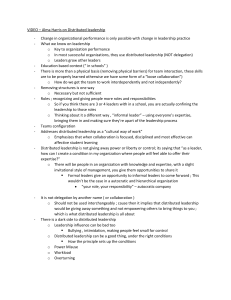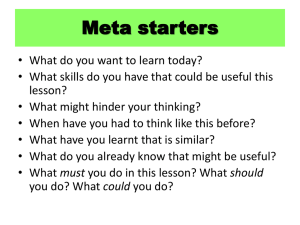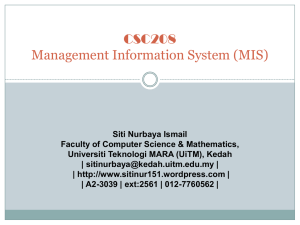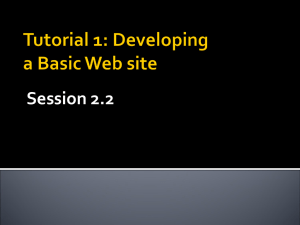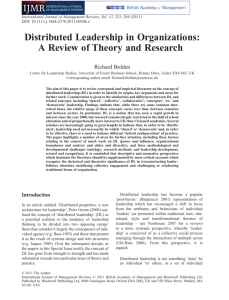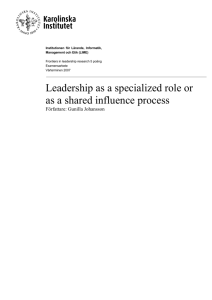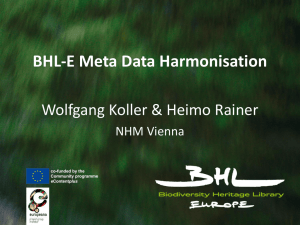School leadership is a mixture of power with and power over as this
advertisement
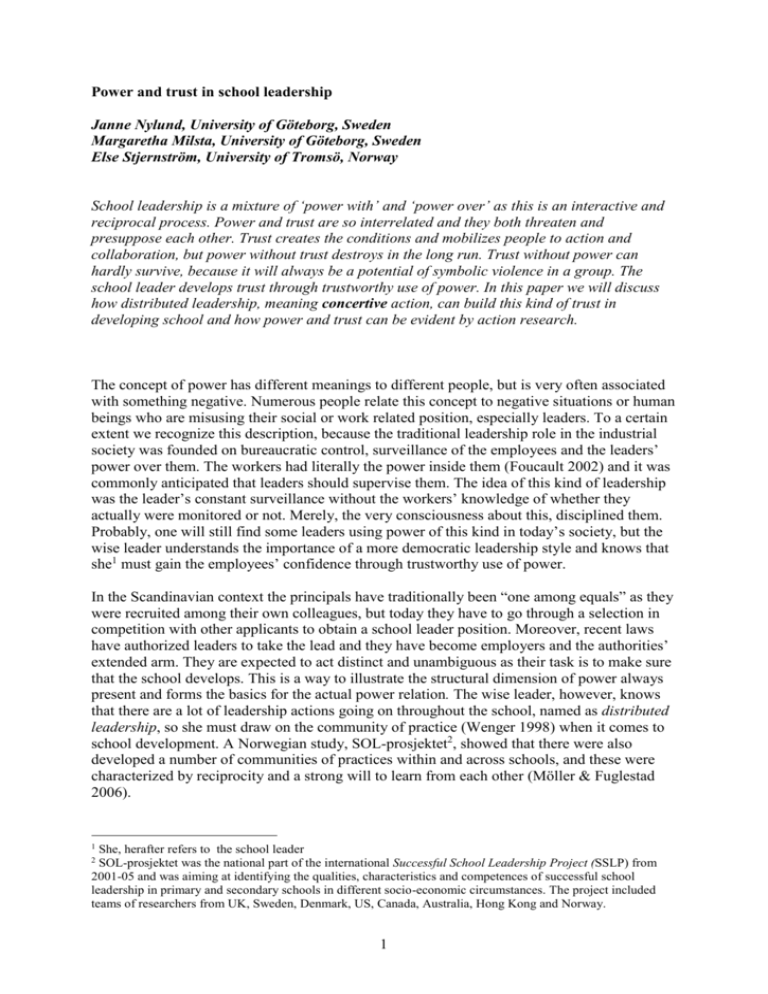
Power and trust in school leadership Janne Nylund, University of Göteborg, Sweden Margaretha Milsta, University of Göteborg, Sweden Else Stjernström, University of Tromsö, Norway School leadership is a mixture of ‘power with’ and ‘power over’ as this is an interactive and reciprocal process. Power and trust are so interrelated and they both threaten and presuppose each other. Trust creates the conditions and mobilizes people to action and collaboration, but power without trust destroys in the long run. Trust without power can hardly survive, because it will always be a potential of symbolic violence in a group. The school leader develops trust through trustworthy use of power. In this paper we will discuss how distributed leadership, meaning concertive action, can build this kind of trust in developing school and how power and trust can be evident by action research. The concept of power has different meanings to different people, but is very often associated with something negative. Numerous people relate this concept to negative situations or human beings who are misusing their social or work related position, especially leaders. To a certain extent we recognize this description, because the traditional leadership role in the industrial society was founded on bureaucratic control, surveillance of the employees and the leaders’ power over them. The workers had literally the power inside them (Foucault 2002) and it was commonly anticipated that leaders should supervise them. The idea of this kind of leadership was the leader’s constant surveillance without the workers’ knowledge of whether they actually were monitored or not. Merely, the very consciousness about this, disciplined them. Probably, one will still find some leaders using power of this kind in today’s society, but the wise leader understands the importance of a more democratic leadership style and knows that she1 must gain the employees’ confidence through trustworthy use of power. In the Scandinavian context the principals have traditionally been “one among equals” as they were recruited among their own colleagues, but today they have to go through a selection in competition with other applicants to obtain a school leader position. Moreover, recent laws have authorized leaders to take the lead and they have become employers and the authorities’ extended arm. They are expected to act distinct and unambiguous as their task is to make sure that the school develops. This is a way to illustrate the structural dimension of power always present and forms the basics for the actual power relation. The wise leader, however, knows that there are a lot of leadership actions going on throughout the school, named as distributed leadership, so she must draw on the community of practice (Wenger 1998) when it comes to school development. A Norwegian study, SOL-prosjektet2, showed that there were also developed a number of communities of practices within and across schools, and these were characterized by reciprocity and a strong will to learn from each other (Möller & Fuglestad 2006). 1 She, herafter refers to the school leader SOL-prosjektet was the national part of the international Successful School Leadership Project (SSLP) from 2001-05 and was aiming at identifying the qualities, characteristics and competences of successful school leadership in primary and secondary schools in different socio-economic circumstances. The project included teams of researchers from UK, Sweden, Denmark, US, Canada, Australia, Hong Kong and Norway. 2 1 As school development is a learning process, all the actors have to participate and cooperate. This is not a leadership action only, but a common task for the community of practice. Even if the individual aspect is significant in some respects, different people have pointed out the importance of focusing on the collective aspect of leadership. Lambert (2002) studied principals carrying heavy burdens beyond the basic demands of their job, and one of his conclusions was: “The days of the lone instructional leader are over” (p.37). He was sure that the principal could no longer serve as the instructional leader without substantial support and participation of others. Philip Hallinger (2005) captured this and said there is a need for a shift in focus from the heroic, individual principal to a distribution of tasks connected to educational leadership, and that leadership must be conceptualized as a mutual influence process (p.28). Peter Gronn (2002) advocates the same view as he argues that “The leadership actions of any individual leader are much less important than the collective leadership provided by members of the organization”. He also claims that the students and the practitioners of leadership would be better served by “a more expanded unit of analysis, bases on a revised conception of leadership” (p. 424). Additionally to Gronn’s interest in leadership, power has been the main focus of his research. In an article (Gronn 2003) he asks if we would be better served if we substitute “leadership” with power or influence since we rather frequently describe leadership as a collective action and the conduct of persons as a part of this process. We perceive his main concern to be that most people have unrealistic expectations to which tasks can be accomplished by a single leader when concealing that leadership is about power and influence. However, the clue here is openness and the construction of true relations between the leader and the employees which reflect their mutual purposes. In a literature search on distributed leadership, Bennet et al (2003) draw on Gronn’s research and point out three distinctive elements of this concept: Firstly, distributed leadership highlights leadership as an emergent property of a group or network of interacting individuals. Secondly, distributed leadership suggests openness of the boundaries of leadership. Thirdly, distributed leadership entails the view that varieties of expertise are distributed across the many, not the few (Bennett et al 2006:7). We will join these perspectives and see how these elements are expressed in practice. Our example shows that the conditions for power and trust towards the leadership are caused by the way the organization is constructed. It is a school where the leadership tasks are expressed in several ways depending on the function to serve. The principal is aware of the tradition that the staff is involved. When she is asked to enumerate the persons involved, she starts telling about the school and how it is organized and mentions by name 12 out of 19 persons within the school besides departments and groups. On a straightforward question about who appoints these representatives, she says that she doesn’t know. R: No, I can tell that I only asked when the term started, who does what... when we plan the meetings for the coming year, and then it is... it’s so obvious when I ask who does that or that. Then the names just come, so I do not know exactly how they alternate. I’m not even sure at all that they really alternate. I think they just go on and when it works all right they don’t violate this, that is if not any person says that she doesn’t want to do so or if she cannot cope with it. 2 The point here is that the construction of the organization is not dependent on the formal leader if she shows that she trusts the way the teachers point out the group members who are going to join the meetings. This doesn’t mean that she doesn’t govern the activities or sets the premises for certain activities. Actually it shows a way of organizing the school so that different kinds of meetings meet different needs. In this school there are quick meetings of 30 minutes duration, in order to make sure that things really happen – to keep up the speed. There are weekly meetings with an intention to discuss didactic considerations which are going to pervade the organization and the way they are expressed in practice. There are working place meetings which fulfil a common influence dimension, and additionally a numerous meetings for special needs. This means that everybody in the school in one way or another are included in a relationship where they have a major responsibility which exceeds their main activity. Thus there is a basis for trust where everybody is expected to contribute to the common good. This trust is founded on the acceptance of the organization’s two learning processes; one adjusted with the intention of getting better implementing common decisions made in meetings. To make the routines work is a mutual task, and on several occasions one of the teachers is writing a letter to the principal to tell how they work. This is to make sure that the principal is prepared for the meetings where the routines are set / decided. The second learning process is more developmental where the openness towards free and creative thinking is a central dimension. The different departments in school are allowed to pursue different developing questions, but it is the principal who co-ordinates various initiatives because she has another role compared to the role of the pedagogical staff. An important aspect is that different persons in the school should be able to act as ideological spokesmen for the school’s main ideas. In this school there are primarily teachers who act as hosts for external visitors and thus inform each other and strangers of the school’s main ideas. Hence different persons advocate different leadership ideas, and in a way they conduct different learning processes. A central issue is how leadership is distributed. The distribution of responsibility for leadership can be based on design. According to Spillane (2005) this can be described in two ways. The first is to create leadership positions or reframing existing positions. The second is to create structures and routines that make distributed leadership come through. In the example from the school mentioned above both seem to exist. Leadership and power are however not only practised on a comprehensive school level, but can rather be seen as a flow throughout the school, which in turn will influence the organization totally. An example from another school shows that adequate routines or structures make it possible for teachers in a team to take the lead in vital discussions through different roles. The new teachers were rapidly integrated in the team, but ”as long as the hard core exist, there are certain roles in the team”. These roles are quite clear in the meaning that NN has gained the confidence of the team and the principal. She has obtained that because of her ambition and as she is regarded as a competent and skilful teacher. She is chairing the meetings and undertakes the role of the leader of the team, but she also advocates the school perspective as she accelerates and makes sure that all questions are discussed. 3 RR stands for stability and identifies himself with the school organisation. He realizes that his subject is not everything any more, but being a contact teacher3 is the most central part of his teacher role and thus he identifies with the school’s meta idea4. His integrity is considerable and he is fearless. He also restrains some of the noise that is about to rise in some meetings. He sees to that it comes to an end before it starts. SS is another senior member who also identifies the school’s meta idea and monitors and contributes to it’s preservation. He also quite often relates to the questions of the school. A fourth member of the team leaves the team during the summer term to join the resource team. Obviously the core members of the team cooperate or share the meta idea of the school. The space for action this gives the team is also of great importance. As an illustration of the work in the team and the team members’ communication with the principal we will give you an example from a specific team meeting. The team meeting started out with a common gathering in the school’s dining room where the principal told them that they should skip a team meeting one Tuesday a month, on the conditions that the teams should appoint a team representative to attend a meeting between the representatives and the school management. The principal gave no further instructions or explanations for the reason of this meeting. He neither encouraged a discussion about circulation among these representatives nor permanent team leaders, and he did not mention anything about their relation to the management team or their own team. This was perceived as a fairly large space of freedom. The meeting in the dining room ended and everybody went to their team meetings. When the question about a monthly day without meetings arose, there was a major approval of this as well as to the idea that the team should meet the management group through a minor constellation – a coordination group. RR started the discussion and he thought they should circulate so the same person didn’t have to attend these meetings every time. This was approved of by the others and they were about to decide when NN said that perhaps there were persons who didn’t want to go to these meetings at all. This made them stop thinking for a while until NN said that she would volunteer for all meetings. She looked upon this as development of her own competence and that she enjoyed doing this. Then of a sudden AA and some of the others thought that may be some others also should get the opportunity to develop. BB joined the discussion and put forward a professional dimension where she advocated the view that nobody should take on such a burden without any compensation. That would be the same as giving away their working effort for free. This argument was supported by a number of colleagues. The discussion went on and they ended up with the decision that those who were in favour of these meetings should build a circulating group. But then some thought this could be interpreted as a lack of interest for school development or no interest in meeting the school management. RR demonstrated very clearly that he abstained from this and that he was not afraid for what the principal should say. He took on a role of guilt, because he with his large influence and as a leading figure placed himself outside. This legitimized the point of view of the others. 3 To be a contact teacher means to take special responsibility for the students who make schoollife difficult for themselves and others. 4 The concept meta idea is used by Tillberg (2004). It means that a school or an organization has an overall idea which the staff relates to and which is visible in their teaching. In this school this idea is: There is room for everybody and it is built on the notion that the school has a special responsibility for the students who cannot cope with the ordinary teaching programme. 4 We consider this kind of discussion as good and productive. It shows some important qualities of leadership in a team. Firstly it is important that SS takes the lead by demonstrating that this is a common task they all are involved in. The teachers’ work is both individually and collectively organized. Thus RR invites all to common effort. Secondly and just as important is that NN is problematizing the point of view up to this moment taken for granted. Because of this there is an opening up for new possibilities for the individual as well as for the collective view, which wouldn’t be possible otherwise. The discussion takes a new turn, it widens out and includes all the team members. Therefore the result in the end is another than originally expected. The example above also rises the question of the relation between distributed leadership and democracy. We want to emphasize that we don’t see distributed leadership as normative, but rather as a frame for describing and analyzing leadership. Distributed leadership generates conditions for democratic leadership, but is not necessarily democratic. Democracy is not only a form, but also a value. In the school from our example the leadership is not distributed on the school level. ”Front regions” (Goffman 1994) where the leadership practice among the teachers can be expressed are missing. However, the democratic values are dispersed throughout the school through concertive action and the power of the principal is based on the trust given by the staff because he stands up for the values included in the school’s general or meta idea. The power is based on the agreement that the school’s basic values are shared by the staff. These values sometimes exceed the formal influence that comes with distributed leadership. In this actual school the principal decided to point out representatives to the coordinating group himself, in spite of the fact that the team had decided otherwise. This caused no resistance as the persons appointed by the principal shared the common values and were bearers of the school’s general idea. This can be described as if the values, that is equvivalent to the content, is estimated higher than the model. A distributed perspective is first and foremost about leadership practice (Spillane 2006:3). To understand the actions and the interactions that describe a distributed leadership perspective, action research may be appropriate. Through action research the persons are involved in the research. They become co-actors in the exploration of their own work in their working environment, and this may help them to understand how distributed leadership is expressed. There are three important aspects in action research when it comes to knowledge of how distributed leadership works. One is about the understanding and the notion of the question. Argyris & Schön (1987) use the concept espoused theories. This indicates the theory a person has about a phenomenon and which she advocates when she is asked. In our example we have used mindmapping as a method. The benefit of this is that it is constructed in cooperation between the researcher and the practitioner. Another benefit with mindmapping is that this can contribute to clarify the person’s understanding of his work. The other aspect is to clarify the forces which guide a person’s actions. It is not guaranteed that the way one perceives one’s own leadership is identical with the actions of the person. In this connection Argyris & Schön (1987) speak about theories-in-use, that is what a principal does and which thoughts and theories that lie behind his or her actions. Here it is useful to do some observations which later on can be used as a base for a conversation about why the principal acts as he or she does. In our example the principal used a tape recorder where he every 15 minutes registered his actions and the reason for that. The registration was done during three days. 5 The third aspect is about a critical attitude. Through a communication process the researcher and the principal research and reflect together on the gathered data, and where this process is the driving force. References: Bennett, N., Wise, Ch., Woods, P. (2003): Distributed Leadership. National College for School Leadership. Foucault, M. (2002): Overvåkning og straff. Oslo: Gyldendal. Goffman, E (1994) Jaget och maskerna. Doubleday & Company INC 1994 Gronn, P. (2002): "Distributed leadership" i K. Leitwood, P. Hallinger (eds.): Second International Handbook of Educational leadership and Administration. Dordrecht, Kluwer Academic Publishers. Gronn, P. (2003): "Leadership: who needs it?" School Leadership & Mangement. Vol 23, No. 3. Hallinger, Philip (2005): "Instructional Leadership: How has the Model Evolved and What have We Learned?" American Educational Research Association, Montreal Canada. Möller, J., Fuglestad.O.L. (ed.) (2006): Ledelse i anerkjente skoler. Oslo: Universitetsforlaget. Spillane, (2006) Distributed leadeadership San Fransisco: Jossey-Bass Wenger, E. (1998): Communities of Practice. Learning, Meaning and Identity. Cambridge: Cambridge University Press. 6
